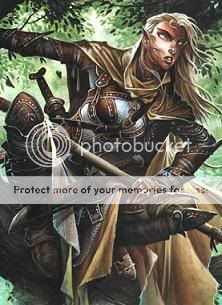Warden (5e Subclass)

|
|---|
| Warden on Patrol |
Warden[edit]
Ranger Subclass
The Warden is a magical avatar of nature that serves as nature's more militaristic aspect of the druidic orders. As a stalwart defender of the natural world, the Warden uses the full force of their might to destroy any that earn nature's ire.
- Barbed Strike
At 3rd level when you hit a creature with a weapon attack, you can expend one ranger spell slot to summon a writhing mass of thorny vines at the point of impact which deals piercing damage to the target, in addition to the weapon‘s damage. The extra damage is 1d6 for a lst-level spell slot, plus 1d6 for each spell level higher than 1st, to a maximum of 5d6.
In addition, the target must make a Strength saving throw against your Spell save DC, or be restrained by the magical vines until the end of your next turn. A Large or larger creature has advantage on this saving throw.
- The Ties That Bind
At 7th level your dedication to the ideals of nature have caught the attention of the nature spirits and they have bestowed a small portion of the power that is usually
reserved for Druids upon you- Choose two cantrips from the druid list, you can cast these cantrips at will.
In addition, you can prepare a list of Druid or Ranger spells equal to your Wisdom modifier each day for casting. The spells must be of a level for which you have spell slots.
You can also change your list of prepared spells when you finish a long rest. Preparing a new list of druid or ranger spells requires time spent in prayer and meditation: at least 1 minute per spell level for each spell on your list.
- Wild Shape
Starting at 10th level you can use your action to magically assume the shape of a beast of your Level's Beast Template CR or less, that you have seen before. You can use this feature twice. You regain expended uses when you finish a long rest.
You can stay in a beast shape for a number of turns equal to half your ranger level (rounded down). You then revert to your normal form unless you expend another use of this feature. You can revert to your normal form earlier by using a bonus action on your turn. You automatically revert if you fall unconscious, drop to 0 hit points, or die.
While you are transformed the following rules apply:
- Your game statistics are replaced by the statistics of the beast, but you retain your alignment, personality and Intelligence, Wisdom , and Charisma scores. You also retain all of your skill and saving throw proficiencies, in addition to gaining those of the creature. If the creature has the same proficiency as you and the bonus in its stat block is higher than yours, use the creature's bonus instead of yours. If the creature has any legendary or lair actions, you can't use them.
- When you transform, you assume the beast’s hit points and Hit Dice. When you revert to your normal form, you return to the number of hit points you had before you transformed. However, if you revert as a result of dropping to 0 hit points any excess damage carries over to your normal form- For example, if you take 10 damage in animal form and have only 1 hit point left, you revert and take 9 damage. As long as the excess damage doesn't reduce your normal form to 0 hit points, you aren’t knocked unconscious.
- You can't cast spells, and your ability to speak or take any action that requires hands is limited to the capabilities of your beast form. Transforming doesn't break your concentration on a spell you've already cast, however, it does prevent you from taking actions that are part of a spell such as call lightning, that you've already cast.
- You retain the benefit of any features from your class, race, or other source and can use them if the new form is physically capable of doing so. However, you can‘t use any of your special senses, such as darkvision, unless your new form also has that sense.
- You choose whether your equipment falls to the ground in your space, merges into your new form, or is worn by it. Worn equipment functions as normal but the DM decides whether it is practical for the new form to wear a piece of equipment, based on the creature‘s shape and size. Your equipment doesn't change size or shape to match the new form, and any equipment that the new form can't wear must either fall to the ground or merge with it. Equipment that merges with the form has no effect until you leave the form.
- Improved Barbed Strike
By 11th level you are so suffused with nature's energy that all your weapon strikes carry a small fragment of nature's wrath with them. Whenever you hit a creature with a weapon, thorny barbs emerge and the creature takes an extra 2d6 piercing damage. If you also use your Barbed Strike with an attack, you add this damage to the extra damage of your Barbed Strike.
- Bladed Spell
Beginning level 15, the Flame Arrows and Lightning Arrow spells can now apply their effects to melee weapon attacks and weapons, as well as ranged weapon attacks, arrows, and quivers. Upon reaching l7th level you can apply this ability to the Swift Quiver spell.
In addition, when casting any of the above spells, you can choose a number of creatures up to your Wisdom modifier (minimum of one creature) to not be affected by the spell.
- Improved Wild Shape
Beginning at level 17th, you are no longer limited to two uses of your Wild Shape ability per long rest.
Back to Main Page → 5e Homebrew → Character Options → Subclasses
